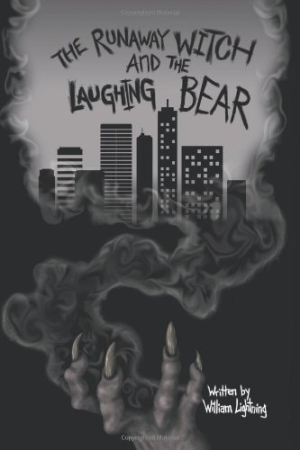It looks like you've stumbled upon a page meant to be read by our code instead of viewed directly. You're probably looking for this page.
The Runaway Witch and the Laughing Bear
Perceptive dialogue adds to the scenery of this novel, conveying both the characters’ personalities and their social context.
Modern urban grit meets traditional folklore in William Lightning’s The Runaway Witch and the Laughing Bear, which tells the parallel tales of two orphans, separated by centuries, through an assortment of diary entries, harrowing scenes of abuse, magical tales, and voices from beyond. The potential for these unique elements to inform each other is great but remains tentative in this brief, underdeveloped novel.
Lightning sketches several compelling characters, though few come with a complete backstory. Drawing on Native American folktales, he is able to conjure up iconic characters like talking bears and wolves in response to modern villains like drug dealers and child pornographers. He captures the tragic viewpoint of a seven-year-old boy named David, who writes heartbreakingly cheerful diary entries while trapped in a dark basement, as well as the viewpoint of forest-dwelling witch Luna, who lives in a house straight out of Hansel and Gretel. Each brief scene is left behind prematurely, giving way to a change in setting or perspective.
Individual scenes, even when unexpected or incomplete, can be quite engaging. When an adult David stops by the roadside and coaxes his five-year-old passenger Bethany into a frightening ritual with underworld spirits, for instance, her fear and her strength are both palpable. It’s a powerful scene, invoking the underlying theme of repressed memories, their power to control, and the need to face them head on. Lightning’s story could be stronger if he expanded on these haunting scenes and spent less time on superfluous and sometimes salacious details, such as David and Bethany’s breakfast at a diner, where David gratuitously grabs a quickie with a cute waitress. Scenes like this contribute little to characterization or plot development.
Relationships figure heavily in Lightning’s tale, but it can be a challenge to separate David’s friends and family from those of his nineteenth-century counterpart, Nathanial. It’s not always clear why Lightning chose to tell two separate stories, since they are parallel and sometimes close to identical. As children, for instance, both David and Nathanial are orphaned and raised by strangers, imprisoned and drugged by evil women, and helped to escape by their female friends. The similarities, combined with the quick switching of scenes, make chapter transitions difficult, as it’s not always immediately clear which story is which.
Lightning is adept with dialogue and varies the voice of his characters convincingly. “The princess is under attack. I must save her!” announces a young Nathanial, while his childhood friend Abigail replies, “Oh, thank you, brave one.” Their playing carries all the innocence of youth, while the profanity-strewn tough talk of the ruthless drug dealers from Los Angeles reveals jaded, morally bankrupt attitudes. The distinctive voices help readers navigate the alternating perspectives, as the narrative switches from Nathanial to David, from forest to city, and from past to present at irregular intervals.
As the cover of The Runaway Witch and the Laughing Bear—a city skyline threatened by the taloned hand of a witch—suggests, this is at heart the story of two worlds colliding. While Lightning could be more cohesive in his exploration of the clash, he does pose intriguing questions about the relative merits of magic and modernity.
Reviewed by
Sheila M. Trask
Disclosure: This article is not an endorsement, but a review. The publisher of this book provided free copies of the book and paid a small fee to have their book reviewed by a professional reviewer. Foreword Reviews and Clarion Reviews make no guarantee that the publisher will receive a positive review. Foreword Magazine, Inc. is disclosing this in accordance with the Federal Trade Commission’s 16 CFR, Part 255.
